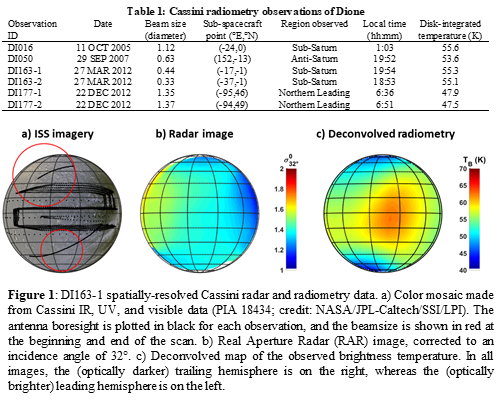Dione's leading/trailing dichotomy at 2.2 cm
- 1Laboratoire d'Etudes Spatiales et d'Instrumentation en Astrophysique (LESIA), Observatoire de Paris-Meudon, LESIA (Bât. 18), 5, place Jules Janssen, 92195 Meudon Cedex, France
- 2Laboratoire Atmosphères, Milieux, Observations Spatiales (LATMOS), UVSQ /CNRS/Paris VI, UMR 8190, 78280 Guyancourt, France
- 3Institut Universitaire de France (IUF), Paris, France
- 4Jet Propulsion Laboratory, California Institute of Technology, Pasadena, CA 91109, USA
1. Introduction
The surface of Dione, Saturn’s fourth-largest moon, is affected by a variety of processes, both exogenic and endogenic, although the satellite does not seem to be active today [e.g., 1]. Like its neighboring mid-sized icy airless satellites Tethys and Rhea, it exhibits a leading/trailing dichotomy, observed at UV to IR wavelengths [e.g., 2].
This dichotomy has also been reported at 2.2 cm wavelengths, in the unique resolved observation acquired by the Cassini Radar on Dione [3, Fig. 1b]. The leading hemisphere is more radar-bright than the trailing hemisphere, implying greater water ice purity on the leading side. This asymmetry may be caused by the deposition of E-ring material on the leading side, and/or by contamination by a non-icy material on the trailing side.
Herein, we examine Cassini radiometry observations of Dione.
2. Dataset and Methods
The active radar observations of Dione conducted by the Cassini Radar have been presented and analyzed by [3–5]. Spatially resolved data were acquired during flyby DI163 in 2012, simultaneously in active (radar) and passive (radiometry) modes. The resulting images are shown in Fig. 1; the resolved radiometry data is deconvolved following the method described in [6,7]. A preliminary analysis of the resolved radiometry also points to a leading/trailing dichotomy. Indeed, the leading hemisphere, during late afternoon, should be radiometrically warmer than the trailing hemisphere, assuming uniform albedo, thermal inertia, and emissivity. The fact that the reverse is observed indicates variations in at least one of these properties.
Distant radiometry scans have been acquired during four flybys. These data and the disk-integrated antenna temperature they yield are summarized in Table 1. We note cooler disk-integrated temperatures at high latitudes. However, any further interpretations require the use of a thermal model.
We simulate the Cassini radiometry antenna temperatures using a combination of thermal, radiative, and emissivity models, similar to the method already applied to Iapetus [8], Enceladus [9], and Rhea [7]. By fitting the simulated antenna temperatures to the observations, we hope to better constrain the thermal, structural, and compositional properties of Dione’s leading and trailing sides. In particular, using the thermal model with the bolometric Bond albedo map derived by [10], it is possible to separate temperature variations caused by local time, albedo, and emissivity, and thus derive a partial emissivity map.

References
[1] C. J. A. Howett et al. (2018), GRL, 45, pp. 5876-5898
[2] P. Schenk et al. (2011), Icarus, 211, pp. 740-757
[3] A. Le Gall et al. (2019), GRL, 46, pp. 11747-11755
[4] S. J. Ostro et al. (2006), Icarus, 41, pp. 381-388
[5] S. J. Ostro et al. (2010), Icarus, 183, pp. 479-490
[6] Z. Zhang et al. (2017), Icarus, 281, pp. 297-321
[7] L. E. Bonnefoy et al. (2020), Icarus, accepted
[8] A. Le Gall et al. (2014), Icarus, 241, pp. 221-238
[9] A. Le Gall et al. (2017), Nature Astronomy, 1, 0063
How to cite: Bonnefoy, L. E., Le Gall, A., Azevedo, M., Lellouch, E., Leyrat, C., and Janssen, M. A.: Dione's leading/trailing dichotomy at 2.2 cm , Europlanet Science Congress 2020, online, 21 Sep–9 Oct 2020, EPSC2020-329, https://doi.org/10.5194/epsc2020-329, 2020.

